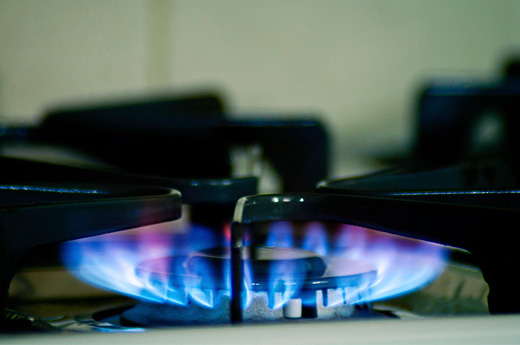
by guest blogger Harriet Shugarman, executive director and founder of ClimateMama and a mentor and climate leader for the Climate Reality Project
In the waning months of 2013, the Spectra Gas Pipeline came “online” in New York City, with scant media coverage. This pipeline has the capability to deliver radioactive gas to the city’s buildings from the Marcellus Shale region in Pennsylvania. Radon gas concentrations in Marcellus natural gas at the “burner tip” of New York’s stoves, boilers, dryers, and water heaters could be 30 to 80 times baseline levels—well above the Environmental Protection Agency’s (EPA’s) “safe” levels for radiation exposure. Yet, so far there seems to be little to no public outcry. Why not? The facts are in, this is real, and it’s potentially deadly.
As a mother, I work hard to ensure that what comes into our home and goes into and on my children’s bodies is as safe and secure as I can possibly make it. Yet, for certain things like the air my children breathe and the water they drink, I need to rely on experts and elected officials to put in place policies, programs, and procedures to guard their safety. Now, it seems, even within the confines of my home, I might not be able to keep my children safe.
New York City’s outgoing mayor, Michael Bloomberg, made it part of his mandate to ban the heaviest heating oils—No. 4 and No. 6, which significantly contribute to air pollution—from NYC buildings. Eliminating those fuels helps meet the PlaNYC goal to reduce soot pollution by 50 percent by 2013, saving lives and preventing asthma-related hospital visits. As with many decisions that are made with the best intentions, this decision had some unintended consequences: Instead of making buildings safer, it may in fact have opened the floodgates to devastating long-term health consequences by setting up building conversions from oil to gas.
Recent research by Jeff Zimmerman Esq. using limited data currently available shows that, based on wellhead measurements and gas travel time between the Marcellus Shale and New York City, radon levels of shale gas delivered to New York City could be anywhere from 32 to 135 picoCuries per liter (pCi/l). Compare this to the EPA warning that anyone with indoor levels of radon at 4 pCi/l or more is in danger and suggestion that mitigation begin at 2 pCi/l, and it appears this doesn’t bode well for New York City residents.
According to Susan Bushkin-Bedient, MD, MPH: “While it may be possible to remove other components of raw natural gas such as ethane, propane, butane and pentanes at natural gas processing centers, it is not possible to remove radioactive substances such as radon. Indeed, radon is the leading cause of lung cancer among non-smokers, and the second leading cause among smokers and indirect (secondhand) smokers.”
Angela Monti Fox, founder of The Mothers Project, has said that “Oil to gas conversion in NYC buildings potentially places city residents at direct exposure to radon from kitchen stoves, gas dryers and home heaters. This leaves mothers whose bellies are at stove level and children and pets who are playing on the floor, where heavy gas drops, more vulnerable.”
While I am neither a scientist nor a medical professional, given the rising chorus of voices that are raising red flags about shale gas and the gas’s proximity to new markets (and therefore potential deadly implications), it would seem to be high time that those in power give this issue front-“burner” importance. As Bill de Blasio, the new mayor of New York City, begins in earnest to set his priorities for his administration, one of his top priorities must be hearings on the health implications of radon in New York City’s gas. New York State Assemblymember Linda Rosenthal has already begun this process.
Not only are we now discovering new and potentially deadly human health reasons to reject natural gas as an expanded energy source, but more than 95 percent of the world’s climate scientists are saying with certainty that we humans are causing our climate to change and that the use of ALL fossil fuels, including natural gas, must be curtailed and ultimately stopped if we are to have a hope for a livable future.
To be sure, we can’t stop using fossil fuels tomorrow, but we can stop supporting and subsidizing fossil fuel companies, and we can demand better scrutiny and review of new fossil-fuel-infrastructure project proposals like pipelines, metering, and compressor stations. In this regard, we can and must demand that “externalities” like our health and welfare are internalized into the costs of all energy projects.
The Spectra pipeline is just one of hundreds of pipelines and fossil-fuel-infrastructure projects being quickly approved by our Federal Energy and Regulatory Committee. These pipelines are snaking their way across our country and into our communities and homes. We need to demand that our elected officials connect the dots. We need to more clearly understand the cumulative impacts of fossil fuels and the entire accompanying infrastructure on our health and the health of our planet. And we need to put the brakes on and slow down our uncontrolled rush forward toward energy independence through the expansion of natural gas and its infrastructure.
Meanwhile, in the short term, wherever you live, it’s time for us to call our mayors, our elected state officials, our congressional representatives, our senators, our governors, and our president. We need to let them know we are concerned and frightened about the very real possibility of radioactive gas coming into our homes, our towns, and our communities, and they should be, too.
 A speaker, writer, and “mom” activist, Harriet travels the country educating and informing audiences about the realities of climate change and how people can feel empowered to take individual and collective action in their homes, businesses, and communities. Harriet spent most of her professional life working as an economist and policy analyst, including 13 years as a representative for the International Monetary Fund at the United Nations. She chairs numerous regional and local environmental committees and works regularly with national, state, and local organizations to lobby for legislative change on environmental issues. Harriet is the mother of two teens, who are her inspiration and motivation for everything that she does!
A speaker, writer, and “mom” activist, Harriet travels the country educating and informing audiences about the realities of climate change and how people can feel empowered to take individual and collective action in their homes, businesses, and communities. Harriet spent most of her professional life working as an economist and policy analyst, including 13 years as a representative for the International Monetary Fund at the United Nations. She chairs numerous regional and local environmental committees and works regularly with national, state, and local organizations to lobby for legislative change on environmental issues. Harriet is the mother of two teens, who are her inspiration and motivation for everything that she does!




Thank you for this information and real life warning. Now it makes more sense why so many people who have never smoked are dying from lung cancer. What will it take for our leaders to stop calling natural gas ‘safe and clean’ when there is nothing safe or clean about it?
I love cooking with gas. I was going to have a gas cooktop installed in my home. I think I’ll keep the electric cooktop now.
Maria….I am so glad that you are taking ACTION against this danger. Your Grandfather led the way in the 70’s for many things, Love Canal has he pushed to make big polluters responsible and to clean up their Act, along side Rachael Carson. Here we are 4 decades, later and Cancer is now the number one killer of our children from the increased environmental pollution, along with poor quality diets from the Standard American Diet and Fast Foods…..He organized letter writing campaigns back then…Prevention Magazine was the Leader in Activism. The Rodale family can really say, ” I told You So!” Keep up the good work, Maria!
“While it may be possible to remove other components of raw natural gas such as ethane, propane, butane and pentanes at natural gas processing centers, it is not possible to remove radioactive substances such as radon.”
does this mean propane does not have the radon gas in it?
Thanks Harriet for a great summary of the radon issue. If you are a New York State resident and this issue concerns you, you can sign this petition in support of the Rosenthal Radon Bill: https://docs.google.com/forms/d/1QupZDOEBvBK-OyVvHmOhFI-e5zUm0AgSGjYBROlBJ_c/viewform
If you live in the 5 boroughs of NYC, you can participate in the Citizen Testing Program: http://saneenergyproject.org/2014/01/08/january-is-national-radon-awareness-month/
@Brenda: There is no testing currently being done on either natural gas or propane used in residential kitchens, so we don’t have clear answers. Propane is separated from methane (natural gas) at the well head, and will also contain radon. However, propane is usually stored in tanks and used in rural homes, which may offer the twin advantages of allowing time for radioactive decay (about 2 months is needed for full decay) and the fact that many country or suburban homes have much better ventilation (or drafts) than poorly-ventilated urban apartments. But until regulations are put in place to test and mitigate for radon in these substances, we just don’t know for sure.
saneenergy I like you comment. I live on top a mountain in the Sierra Mountains….propane or electric is the only option.
I will pass this petition around to my groups and target NY.
It was Robert Rodale Senior who taught me how to be an Activist. Waking up folks and lifting the awareness and taking Action!
saneenergy I like you comment. I live on top a mountain in the Sierra Mountains….propane or electric is the only option.
I will pass this petition around to my groups and target NY.
You will have to build roads and car parking areas and plot trash cans besides every
tent to make sure you meet the requirements of your customers.
One of the most subtle actions of the stock market that most people don’t realize is, 75% of all trading done is through high frequency trading algorithms
(HFT). If you do not know how large a forex market is, heres an example:
All bond, commodities, stock, and futures market combined should operate for 24hours a day in three
months to produce the volume of money traded in the forex market in
one day.